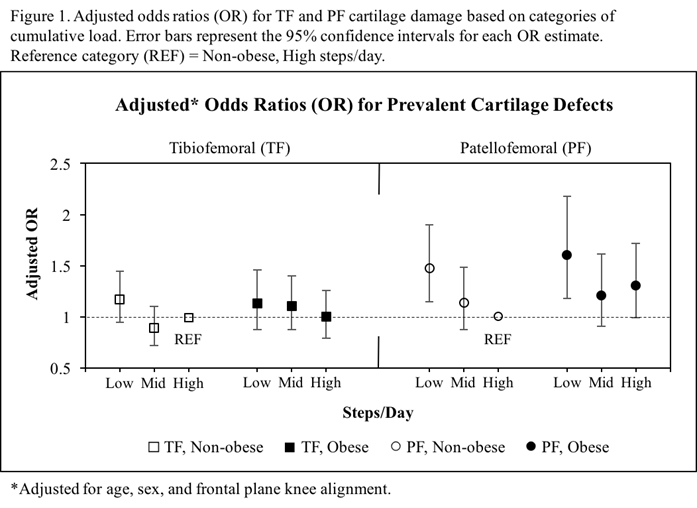Session Information
Date: Wednesday, November 8, 2017
Title: Osteoarthritis – Clinical Aspects II: Structural Progression and Incidence
Session Type: ACR Concurrent Abstract Session
Session Time: 11:00AM-12:30PM
Background/Purpose: Cartilage damage, which is a precursor and feature of knee osteoarthritis (OA), has been linked to both obesity and excessive joint loading. Assessment of the combined effect of obesity and repetitive joint load as experienced during daily walking to represent cumulative load may provide additional insights into the risk for cartilage pathology in OA. The purpose of our study was to examine the relation of cumulative load to prevalent cartilage damage in the tibiofemoral (TF) and patellofemoral (PF) joints in people with or at high risk of knee OA.
Methods: Data from the 60-month visit of the Multicenter Osteoarthritis (MOST) Study, a NIH-funded longitudinal cohort of persons with or at risk of knee OA, was used for this study. Subjects had accelerometry data over 7 days (StepWatch Activity Monitor, Orthocare Innovations) and knee MRIs (1.0T, OrthOne) obtained at this visit. The primary exposure of interest was categories of cumulative load, defined using BMI and objectively measured physical activity (i.e. average steps/day). We categorized participants as Non-obese (BMI<30 kg/m2) or Obese (BMI³30 kg/m2), and then into tertiles of daily walking as High, Middle, and Low steps/day. Cartilage morphology was scored in 14 subregions (10 TF, 4 PF) using the Whole Organ Magnetic Resonance Imaging Score (WORMS). We examined the relation of cumulative load to the presence of cartilage damage, defined as any WORMS score ³2, using logistic regression with generalized estimating equations (GEE) to account for the correlation between subregions within a knee. Analyses were adjusted for age, sex, and frontal plane knee alignment.
Results: We included 987 MOST subjects (62% women, age 66.9 ± 7.5 years, BMI 29.7 ± 4.8) that contributed 9610 TF observations and 3734 PF observations. The prevalence of TF cartilage damage was 27% (2619/9610 subregions) and 48% (1791/3734 subregions) for PF cartilage damage. Cumulative load was not associated with TF cartilage damage (see Figure 1). In the PF joint, there was a higher likelihood of prevalent PF cartilage damage for those in the Obese-High 1.3(0.99-1.7), Obese-Low 1.6(1.2-2.2), and Non-obese-Low 1.5(1.1-1.9) groups compared with the reference (Non-obese, High steps/day) group (see Figure 2).
Conclusion: Greater cumulative load may be associated with prevalent cartilage damage in the PF, but not TF joint. Insufficient cumulative load (i.e. low steps/day) may also be associated with prevalent PF cartilage damage. These preliminary findings support the need to encourage weight loss for people who are obese and at risk of knee OA in addition to an active lifestyle.
To cite this abstract in AMA style:
Mathews D, Neogi T, Stefanik J, Guermazi A, Roemer F, Thoma L, Master H, Christiansen M, Lewis CE, Nevitt MC, Torner J, White D. The Relation of Cumulative Load to Prevalent Cartilage Damage in the Knee [abstract]. Arthritis Rheumatol. 2017; 69 (suppl 10). https://acrabstracts.org/abstract/the-relation-of-cumulative-load-to-prevalent-cartilage-damage-in-the-knee/. Accessed .« Back to 2017 ACR/ARHP Annual Meeting
ACR Meeting Abstracts - https://acrabstracts.org/abstract/the-relation-of-cumulative-load-to-prevalent-cartilage-damage-in-the-knee/

